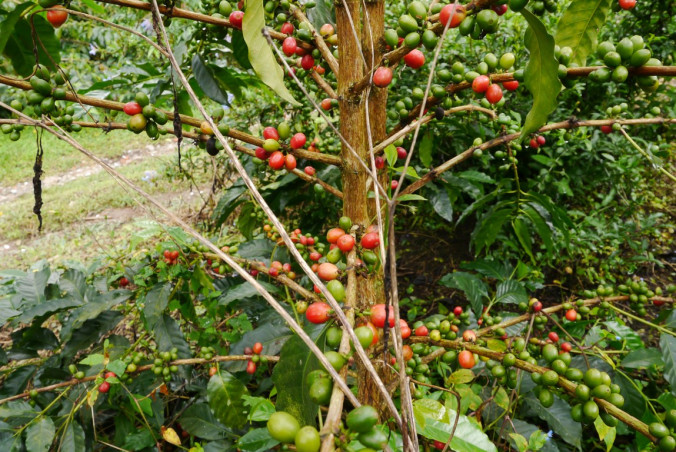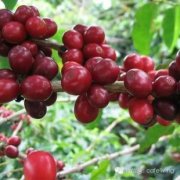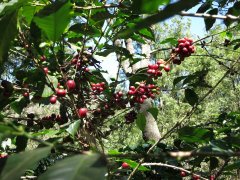The history of the fight against leaf rust in the coffee industry in Colombia-a disease that coffee lovers must know about

For professional baristas, please follow the coffee workshop (Wechat official account cafe_style)
If you landed in Bogota by plane in the 1960s, the first sign that came out of the airport might be a huge sign that read in a stern tone: "Coffee leaf rust is the enemy. Please do not bring plants into the country from abroad."
This is the first warning of leaf rust since the birth of the Colombian coffee trade.
Coffee is an important product in Colombia, one of the largest industries in the country and one of the most important sources of foreign exchange. Leaf rust is likely to hit it hard and even destroy the entire coffee industry. Last year alone, Colombian coffee exports reached US $2.4 billion, accounting for 7.7 per cent of total exports. This also makes Colombia the third largest coffee producer in the world. In other words, if leaf rust takes root in Colombia, the global supply of coffee will decline, which will affect the price of coffee around the world.
It is for this reason that scientists in Colombia have been fighting a little-known battle against the disease for decades. Their battlefield is in a small laboratory deep in the mountains of Columbia coffee growers.
The question is, can the unique flavor of Colombian coffee be preserved intact?
Leaf rust has plagued coffee farmers for more than a century. When a tree is infected with the disease, its leaves produce a fine brown powder that can be rubbed off like rust. The disease is caused by Hemileia vastatrix, which causes the leaves of coffee trees to fade from bright green to brown. Finally, all the leaves of the coffee tree will fall off, unable to grow coffee beans.
If ignored, the disease will have serious consequences. At the end of the 19th century, Sri Lanka, the Philippines and some countries in Southeast Asia were the world's most important coffee exporters. In just a few decades, the disease has led to the near extinction of coffee farming in these countries.
Historians believe this is part of the reason why Britons now prefer tea. "Sri Lanka has turned to tea production," because growing coffee is no longer profitable, explains Aaron Davis, director of coffee research at Royal Botanic Gardens, Kew, the Royal Botanical Garden. Fortunately for Asian producers, when the supply of coffee disappeared, the British turned to tea.
Beauty and the Beast
Leaf rust worries Colombia because it attacks exactly what the country relies on-and a coffee tree that coffee lovers are used to drinking.
There are two kinds of coffee trees. We call it "Beauty" and "Beast".
"Beauty" is Arabica coffee (Coffea arabica). Its seeds can bring delicious and exquisite coffee, and the price is very high in the international market. It is this kind of coffee that makes Colombian coffee world-famous.
"Beast" is Coffea canephora, also known as robusta. This kind of coffee has strong vitality, strong disease resistance of leaves and low cost of planting and harvest. Its taste is rough and bitter, it is not very attractive to coffee tasters, and its market evaluation is not as good as soft Arabica coffee. As a result, it accounts for only 37 per cent of global coffee production, according to the International Coffee Organization (International Coffee Organisation).
Unfortunately, leaf rust attacks "beauty", not "beast". Colombia only exports "beauty" coffee, so changing the type of coffee is not the solution.
In the 1960s, a team of scientists called Cenicafe Lab began to try to use the optimal characteristics of two varieties of coffee trees to find a solution to the problem, but the problem was not that simple.
Laboratory
To get to the Cenicafe lab, you need to drive all the way to the top of the mountain. If you are not used to the mountain road, you may get carsick. The lab was chosen to protect 89-year-old research from natural forces: when the volcano erupted in 1985, the previous laboratory building was flooded with lava.
The laboratory was established by the National Federation of Colombian Coffee growers (National Federation of Coffee Growers). This coffee industry association is considered to be the flagship center of coffee science in the world.
"it is Cenicafe Labs that allows us to stay competitive and reduce risk," explains Hernando Duque, technical director of the National Federation of Colombian Coffee growers. The laboratory's research has promoted the domestication and survival of many of Colombia's world-famous high-quality coffee species.
Today, laboratory work is hailed as a golden rule against "the most serious threat to coffee in the Americas", says Michael Sheridan Sheridan, head of procurement at Intelligentsia Coffee Roasters, a US boutique coffee importer.
In order to save Colombian coffee, Cenicafe scientists realized in the 1960s that they needed to cultivate new coffee varieties, inheriting the unique taste and aroma of Colombian "beauty" coffee on the one hand, and preserving the genes of "beast" with strong disease resistance on the other.
To do that, they have to get these genes from somewhere: because Beauty and the Beast don't usually interbreed.
They found a solution on the other side of the world.
Love from East Timor
In recent history, strange things have happened in East Timor. East Timor is a small island country in the Indian Ocean between Indonesia and Australia. Here "Beauty" and "Beast" have some kind of hybrid, so there is East Timor Hybrid Coffee.
This naturally occurring hybrid of Arabica and Robusta was discovered in 1927 and harvested in 1940. The fruit of this coffee doesn't taste particularly good, but it has a key feature: unlike ordinary robusta coffee, it can cross with Arabica coffee, which means it can inherit resistance to leaf rust.
Coffee research institutions around the world are starting to adopt this approach, but there is another problem. The taste of the hybrid is not very good, which means that the work will fail. If coffee growers earn less from planting new varieties than old ones, they will not grow new coffee at all.
Cenicafe began working on ways to fight leaf rust in 1968 because they knew it would soon spread from overseas to Colombia. The laboratory launched a project to cultivate varieties that are resistant to leaf rust. It's not just about mixing the genes of the two varieties. The actual work is to cross among five generations of tree species, and then select varieties with good taste, delicate aroma, short, high yield and resistance to many kinds of camel rust.
In 1980, the center released the first hybrid coffee tree, a hybrid between Kaddura, the mainstream coffee tree in Colombia, and the East Timorese hybrid. It is called the Colombian species, and its quality is good enough to conquer growers and buyers. There are still many coffee farms in Colombia that grow Colombian coffee.
The time node is just right. Three years later, Colombia discovered the first case of leaf rust.
Moving target
The successful development of the Colombian species did not end the war against leaf rust. Camel rust later began to evolve, finding a way to parasite coffee trees that were immune to it. Although the Colombian species maintains some of its disease resistance, camel rust can always find ways to break its immunity.
And the threat of climate change. Temperatures are rising during the coldest period of the year, which some scientists believe will shorten the time it takes for camel rust to attack after it comes into contact with coffee trees. As a result, future infectious diseases are likely to last longer and more destructive.
With this in mind, Cenicafe has also developed a number of other varieties. In 2005, they released a new coffee seed called Castillo, after Jaime Castillo Zapata, the scientist who led the study. In 2016, the third coffee variety, Cenicafe1, increased its resistance to other diseases.
The main idea is to make it more difficult for fungi to defeat the immune mechanism of coffee trees. To do this, many different genes are used to fight pathogens. If some genes are defeated by mutations in camel rust, there are many other genes that can play a role.
Coffee scientists are trying to protect coffee trees from other risks by expanding the gene pool. "if you reduce genetic diversity, coffee trees will also become less resistant to climate, pesticides and disease," Davis explained.
Other cash crops have shown that lack of genetic diversity can have disastrous consequences. Today, most of the bananas you can buy in most parts of the world are cloned from a parent plant, Cavendish, which was first cultivated in England in the 19th century.
Although Xiangya banana is not the most delicious, it has resisted the fungus that led to the extinction of the most popular variety, Rice Seven Banana (Gros Michel), in the mid-20th century. Now the fungus has mutated again, which means that one day bananas may also become extinct.
Coffee scientists already know this cautionary tale. In the distant future, when leaf rust finally defeats Castile and Columbia, we can only hope that other varieties will be resistant to leaf rust.
Beyond the seed
If leaf rust has a firm foothold, it will cause economic and human losses. Colombia's coffee industry employs about 730000 people, most of them in poor rural areas.
Sheridan of intellectual Coffee, an American coffee manufacturer, worked on poverty alleviation and development in Colombia for many years. He saw many small coffee farms gamble everything in the hope of a good harvest. They take a high risk, and if something goes wrong, their families will pay a heavy price.
It is for this reason that he believes that variants like Castillo can keep many small coffee farms alive because they now have reasonable prices and low-risk options. "it's not a question of choice, it's a question of necessity." He said.
Seeds are only part of the problem. It will be difficult for coffee growers to change to varieties that are resistant to disease. The peak fruiting period of a coffee tree can be as long as eight years, which means that after the release of new seeds, most of them will not be accepted by growers immediately.
In addition, many growers have feelings for the varieties they have already planted. They know the temper and growth process of trees, as well as the way coffee trees survive in the special environment of their farms. Even though Castius and Kaddura grow in very similar ways, for some coffee ranchers, planting new seeds is like entertaining strangers at home.
This change will also bring economic losses. In a recent paper on leaf rust, a team of Latin American coffee researchers wrote that variety replacement requires a large initial investment and "will produce little for at least the first two years, resulting in a significant reduction in income."
Colombia has proposed strategies to overcome these difficulties. The National Federation of Coffee growers provides subsidies and loans to coffee farmers to help them buy disease-resistant seeds and provide technical guidance on planting.
However, leaf rust can still wreak havoc on the coffee industry. An outbreak in 2008 cut coffee production in Colombia by 1/4. Since then, Colombia has accelerated its efforts to help coffee farmers grow Castilla.
Currently, according to the National Federation of Coffee growers, at least 76% of Colombian coffee trees are resistant to leaf rust to some extent, mainly due to Colombia's efforts to promote the cultivation of Castillo. During recent leaf rust outbreaks, coffee production in other countries halved, but Colombia kept the percentage of infection in single digits.
As a result, most people in the coffee industry, from coffee growers to scientists to buyers, believe that Colombia is the best in the world in the fight against leaf rust. But not everything is good, and the taste of the new variety has not been widely praised.
Main number
Once a year, coffee ranchers line up the fruits of their hard work in front of a team of cup testers (professional quality appraisers in the industry). Their goal is to achieve a magic score of 80.
The cup tester rated the flavor of the coffee out of 100-to assess aroma, consistency, sweetness, and so on. To become a "boutique coffee", it must reach at least 80 points, so that its price can be higher than the market average. Some buyers are even more picky: they demand 83 or even more than 87. Of course, they will pay the corresponding price for high quality.
In addition, it is also an affirmation of the skills of coffee growers. Scoring will put them among the elite of the coffee growing industry.
"it's hard to get to that level," said Maurizio Mauricio Castaneda, the eldest son of a coffee grower family. "you have to take care of a lot of small details." In 2016, only 17% of Colombia's exports of coffee beans reached the water bar.
Some people in the coffee market think Castiouda doesn't have access to this water bar. For years, some coffee cup testers have complained that Castillo's quality and cup test results are lower than those of Kaddura-a claim that could prevent the disease-resistant variety from surviving.
This is a controversial issue in the coffee industry. For example, Alejandro Cadena, chief executive of coffee trading company Caravela, said: "Castile is not very suitable for a professional, high-quality market." 'Sometimes it smells a little rubber, especially when the process is incorrect,'he said.
This causes it to miss the high-quality market with higher prices. But Cadena believes that, "in the more commercial, high-volume market, Castile excellent performance is very outstanding."
Sheridan and others hold a different view. Based on his 2014 research in Nari ñ o, one of Colombia's coffee producing regions, Sheridan claimed that some professional cup testers blindly judged the two coffee beans, but did not find any significant differences.
He cautioned that the study could not be used to speculate about other producing areas in Colombia or coffee beans from other years. He claims that there are many signs in the market that the value of Castillo is rising. Top baristas choose it when they take part in the competition. Castillo also has a very good reputation among international buyers. "when you want to buy coffee beans from a small farm, it's getting harder and harder to find batches that don't contain any Castile," he said.
Castiao also won the heart of Educardo Flores. He is a Colombian entrepreneur who runs a coffee stall in London's Borough Market market and sells coffee he bakes in his garage in Brighton. He buys small batches of coffee beans and finds some very special Castios. "once, I also found one with a peach flavor." He pointed it out to me excitedly. "imagine how delicate it should be!"
In Flores's garage, I decided to do a cup test myself (I'm not an expert and I'm not representative). I tasted four samples without knowing the variety of coffee.
The flavor of one of them is complex and worth sipping many times: its fruit-like acidity and sweetness seems to be dancing, and each flavor does not cancel each other out, but complements and enhances each other. The other sample tastes like office coffee, which is very refreshing after drinking it. The other two are between this good sample and the ordinary sample.
What is my favorite sample with fruit flavor and sweetness? It's Castius.
Important Notice :
前街咖啡 FrontStreet Coffee has moved to new addredd:
FrontStreet Coffee Address: 315,Donghua East Road,GuangZhou
Tel:020 38364473
- Prev

Detailed description of coffee from Tega and Tula Farm Tega and Tula Farms in Lim, Ethiopia
Professional barista exchanges please follow the coffee workshop (Wechat official account qianjiecoffee) Ethiopia Lim Tega and Tula Farm Taiga and Tula Farm sun-dried organic beans in Ethiopia will add 3 and 4 after the name to make a distinction (with 3 better quality), coffee cherries will be harvested with peel and pulp in the drying farm immediately until the coffee is dry.
- Next

Method of distinguishing commercial coffee producing areas and fine coffee producing areas in Colombia Colombian coffee logo
Exchange of professional baristas pay attention to Coffee Workshop (Wechat official account cafe_style) Colombia's geographical environment is excellent: low latitudes, high elevations, coffee trees are mostly planted in the Andes, between 1200 and 1900 meters above sea level, and the planting area from south to north, staggered production seasons, coffee production throughout the year, becoming the world's third largest coffee supplier. In particular, Colombia
Related
- Detailed explanation of Jadeite planting Land in Panamanian Jadeite Manor introduction to the grading system of Jadeite competitive bidding, Red bid, Green bid and Rose Summer
- Story of Coffee planting in Brenka region of Costa Rica Stonehenge Manor anaerobic heavy honey treatment of flavor mouth
- What's on the barrel of Blue Mountain Coffee beans?
- Can American coffee also pull flowers? How to use hot American style to pull out a good-looking pattern?
- Can you make a cold extract with coffee beans? What is the right proportion for cold-extracted coffee formula?
- Indonesian PWN Gold Mandrine Coffee Origin Features Flavor How to Chong? Mandolin coffee is American.
- A brief introduction to the flavor characteristics of Brazilian yellow bourbon coffee beans
- What is the effect of different water quality on the flavor of cold-extracted coffee? What kind of water is best for brewing coffee?
- Why do you think of Rose Summer whenever you mention Panamanian coffee?
- Introduction to the characteristics of authentic blue mountain coffee bean producing areas? What is the CIB Coffee Authority in Jamaica?

